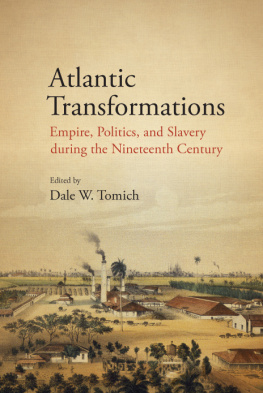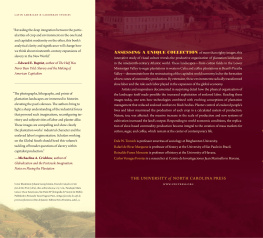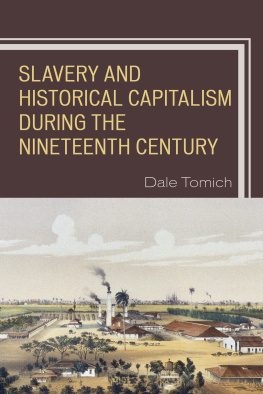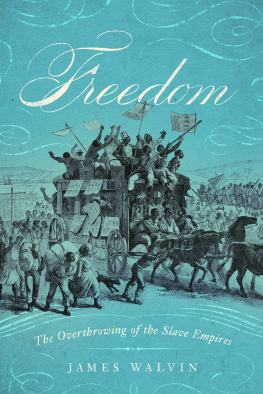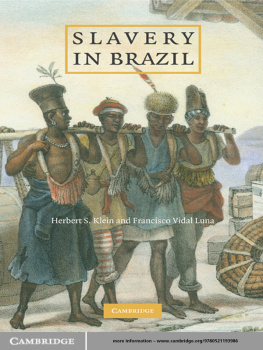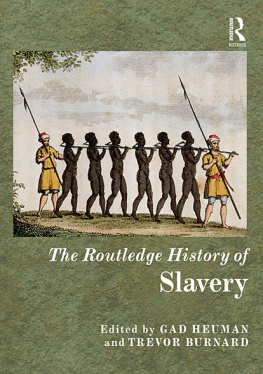
The Politics of the Second Slavery
FERNAND BRAUDEL CENTER
STUDIES IN HISTORICAL SOCIAL SCIENCE
Series Editor: Richard E. Lee
The Fernand Braudel Center Studies in Historical Social Science will publish works that address theoretical and empirical questions produced by scholars in or through the Fernand Braudel Center or who share its approach and concerns. It specifically seeks to promote works that contribute to the development of the world-systems perspective engaging a holistic and relational vision of the worldthe modern world-systemimplicit in historical social science, which at once takes into consideration structures (long-term regularities) and change (history). With the intellectual boundaries within the sciences/social sciences/humanities structure collapsing in the work scholars actually do, this series will offer a venue for a wide range of research that confronts the dilemmas of producing relevant accounts of historical processes in the context of the rapidly changing structures of both the social and academic world. The series will include monographs, colloquia, and collections of essays organized around specific themes.
VOLUMES IN THIS SERIES :
Questioning Nineteenth-Century Assumptions about Knowledge, I: Determinism
Richard E. Lee, editor
Questioning Nineteenth-Century Assumptions about Knowledge, II: Reductionism
Richard E. Lee, editor
Questioning Nineteenth-Century Assumptions about Knowledge, III: Dualism
Richard E. Lee, editor
The Longue Dure and World-Systems Analysis
Richard E. Lee, editor
New Frontiers of Slavery
Dale W. Tomich, editor
Slavery in the Circuit of Sugar: Martinique and the World-Economy, 18301848
Dale W. Tomich
The Politics of the Second Slavery
Dale W. Tomich, editor
The Politics of the Second Slavery
Edited by
Dale W. Tomich
FERNAND BRAUDEL CENTER
STUDIES IN HISTORICAL SOCIAL SCIENCE
Cover: photo of Ingenio Dolores Abreu in Remedios, Cuba taken by Dale W. Tomich.
Published by State University of New York Press, Albany
2016 State University of New York
All rights reserved
Printed in the United States of America
No part of this book may be used or reproduced in any manner whatsoever without written permission. No part of this book may be stored in a retrieval system or transmitted in any form or by any means including electronic, electrostatic, magnetic tape, mechanical, photocopying, recording, or otherwise without the prior permission in writing of the publisher.
For information, contact State University of New York Press, Albany, NY
www.sunypress.edu
Production, Ryan Morris
Marketing, Kate R. Seburyamo
Library of Congress Cataloging-in-Publication Data
Names: Tomich, Dale W., 1946
Title: The politics of the second slavery / edited by Dale W. Tomich.
Description: Albany : State University of New York Press, [2016] | Series: Fernand Braudel Center studies in historical social science | Includes bibliographical references and index.
Identifiers: LCCN 2016005981 (print) | LCCN 2016023474 (e-book) | ISBN 9781438462370 (hardcover : alk. paper) | ISBN 9781438462387 (e-book)
Subjects: LCSH: SlaveryAmericaHistory19th century. | SlaveryPolitical aspectsHistory19th century. | DecolonizationAmericaHistory19th century. | Elite (Social sciences)Political activityHistory19th century. | Slave tradeHistory19th century. | Antislavery movementsHistory19th century. | Slave insurrectionsHistory19th century. | AmericaRace relationsHistory19th century. | AmericaPolitics and government19th century.
Classification: LCC HT1048.P65 2016 (print) | LCC HT1048 (ebook) | DDC 306.3/620973dc23
LC record available at https://lccn.loc.gov/2016005981
10 9 8 7 6 5 4 3 2 1
In memory of our colleague and friend Chris Schmidt-Nowara (19662015)
CONTENTS
Dale W. Tomich
Dale W. Tomich
Rafael Marquese and Tmis Parron
Christopher Schmidt-Nowara
Jos Antonio Piqueras
Lus Miguel Garca Mora
Ricardo Salles
Leonardo Marques
Anthony E. Kaye
Enrico Dal Lago
Introduction
Dale W. Tomich
The concept of the second slavery calls attention to the remaking of Atlantic slavery as part of the material and economic expansion of the capitalist world-economy during the first part of the nineteenth century. It refers to both the opening of new zones of slave commodity productionmost prominently the U.S. cotton zone, the Cuban sugar zone, and the Brazilian coffee zoneand the decline of older zones of slave production. By emphasizing the social and geographic reconfiguration of slave relations within a new world-economic complex of relations and processes, the second slavery breaks with linear conceptions of temporality and causality, particularly with linear conceptions of the relation of slavery and capitalist modernity. Thus, rather than treating slave relations as premodern or static, it calls attention to their heterogeneity and complexity and views them as continually formed by and formative of the world-economic division of labor.
This book seeks to deepen our understanding of the second slavery by exploring its political dimensions. Although studies of the second slavery have tended to focus on the social and material conditions of commodity production and the reconstitution of slave relations, the concept does not apply simply to the economic history of slavery. Rather, the second slavery reconfigured slave formations in the Americas within the context of a global and regional political transformation marked by the growth and consolidation of national states. Consequently, the concept of the second slavery suggests, and indeed requires, reinterpretation of the history of slavery in its political, ideological, and cultural dimensions as well as its social, economic, and environmental aspects. While the world-economy provides the analytical framework for this book, political action and discourse are regarded here as spatially and temporally complex and multidimensional. A discussion of the politics of the second slavery needs to take into account diverse groups of actors and institutions, exploring the ways that they interact across multiple spatial and temporal dimensions. Accordingly, the chapters of this book examine how the politics of slavery and antislavery shaped the Atlantic political order, the politics of empire and relations between metropolis and colony, the political contention between old and new slave zones, and slavery and state formation in the postcolonial Americas, as well as slave resistance.
Even as the topics are diverse, three key claims shape the second-slavery approach that we pursue in these chapters. First, all politics, even apparently local politics, are grounded in the transnational structures forming the world-economy and interstate system. Second, the all-too-often-assumed opposition between liberal antislavery and antiliberal proslavery must be critically reexamined. Finally, the narrative of a presumed linear movement from slavery to freedom needs to be called into question. In contrast to these prevailing assumptions, the second-slavery approach explores the diverse and contradictory ways that both abolitionism and proslavery politics are constituted and reconstituted within the historical processes of capital accumulation, state formation, and the articulation of liberal political and economic conceptions. This perspective allows us to differentiate apparently similar phenomena and determine their specificity within world-historical processes. It results, for example, in a reevaluation of proslavery politics. From this perspective, the chapters in this book reinterpret old questions and raise new ones. They call attention to the diversity and transnational character of the politics of slavery and antislavery. They seek to open a discussion rather than to provide answers.


